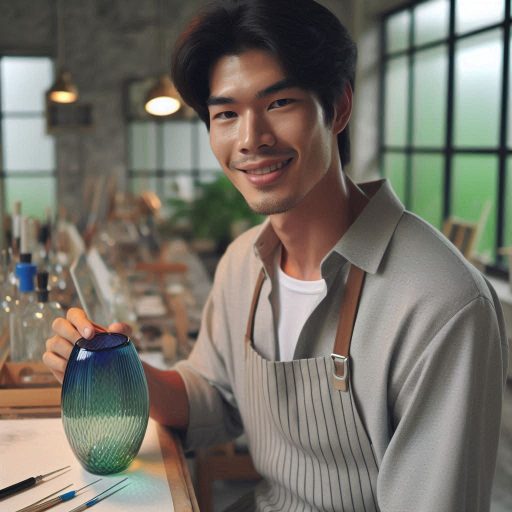Introduction
Glass art encompasses a variety of techniques that manipulate glass to create functional or decorative pieces.
Artists use methods like blowing, casting, and fusing to shape glass into stunning artworks.
In contrast, traditional art forms include painting, sculpture, and drawing.
These forms have a long history, rooted in various cultures around the world.
Glass art has a rich history dating back to ancient civilizations.
The Egyptians and Romans were among the first to create glass objects, often using techniques like glassblowing.
Over time, glass art evolved significantly, incorporating new styles and technologies.
Today, artists continue to push the boundaries of this medium, exploring its potential for expression and innovation.
Traditional art forms have their own deep histories.
Painting, for example, dates back to prehistoric cave paintings.
Sculpture emerged in ancient Greece and Rome, highlighting the human figure and the beauty of the natural world.
These art forms have continued to evolve, influenced by cultural changes and technological advancements.
Both glass art and traditional art forms offer unique perspectives on creativity.
They reflect the skills and imaginations of artists throughout history.
Understanding their definitions, histories, and evolutions provides a foundation for appreciating their differences and similarities.
Each form holds a distinct place in the art world, contributing to the rich tapestry of human expression.
Comparison in terms of materials used
When comparing glass art with traditional art forms, one of the key differences lies in the materials used.
Let’s take a closer look at this aspect:
Materials Used in Glass Art
Glass art, as the name suggests, primarily involves the use of glass as the main material.
This can include various types of glass such as stained glass, fused glass, blown glass, or even recycled glass.
Transform Your Career Today
Unlock a personalized career strategy that drives real results. Get tailored advice and a roadmap designed just for you.
Start NowEach type of glass has its unique characteristics and properties that artists can leverage to create stunning pieces of art.
In addition to glass, artists may also incorporate other materials into their glass artwork, such as metals, wood, or even organic materials like plants or flowers.
These additional materials can add depth, texture, and contrast to the final piece, enhancing its overall aesthetic appeal.
Materials Used in Traditional Art Forms
Traditional art forms encompass a wide range of mediums, including but not limited to painting, drawing, sculpture, and printmaking.
The materials used in traditional art forms can vary greatly depending on the specific medium and technique employed by the artist.
For example, painters may use oil paints, acrylics, watercolors, or even pastels to create their artworks.
Sculptors, on the other hand, may work with materials such as clay, marble, bronze, or wood to bring their sculptures to life.
Printmakers often use techniques like etching, lithography, or screen printing to produce their prints on paper or fabric.
Comparison
Glass art primarily uses glass as the main material, offering a unique translucency and light-refracting properties that traditional art forms cannot replicate.
In contrast, traditional art forms rely on a wide range of materials, each with its own textures, colors, and qualities that contribute to the final artwork.
While glass art allows for experimentation with different types of glass and mixed media, traditional art forms offer artists the flexibility to work with a diverse range of materials, from paints and clay to metals and fabrics.
Both glass art and traditional art forms require a mastery of materials and techniques to achieve the desired artistic expression, showcasing the artist’s skill and creativity.
In essence, the choice of materials in art plays a significant role in shaping the final outcome of a piece.
Whether working with glass or traditional mediums, artists can harness the unique properties of each material to create visually stunning and emotionally engaging artworks.
Read: Exploring Modern Glass Art Trends
Techniques and processes
Glass art involves techniques such as glassblowing, fusing, slumping, and lampworking.
Traditional art forms typically use techniques like painting, drawing, sculpting, and printmaking.
Different techniques and processes involved in creating glass art
Glassblowing is a technique where glass is melted and blown into a bubble with the help of a blowpipe.
Fusing involves melting glass pieces together in a kiln to create intricate patterns and designs.
Showcase Your Business Today
Reach thousands of readers actively exploring professional services. Publish your business profile and grow your audience now.
Publish NowSlumping is the process of shaping glass by melting it over a mold in a kiln.
Lampworking is a method that involves melting glass using a torch to create small intricate designs.
Compare these techniques with those used in traditional art forms
Painting in traditional art involves using brushes and pigments to create images on a canvas or paper.
Drawing utilizes pencils, pens, or charcoal to create a composition on a surface.
Sculpting is the process of carving and shaping materials like clay, stone, or wood to create 3D artworks.
Printmaking involves creating images on a matrix like a woodblock or metal plate and transferring it onto paper.
Overall, both glass art and traditional art forms require skill, creativity, and patience to master their respective techniques and processes.
While glass art may involve more specialized equipment and materials, traditional art forms allow for a wider range of mediums to work with.
Each form of art offers unique challenges and opportunities for artists to express themselves creatively.
Read: How to Market Your Mural Art Business Effectively
Aesthetics and Aesthetics
When it comes to the realm of art, aesthetics play a crucial role in determining the beauty and significance of a piece.
This section will delve into the unique aesthetic qualities of glass art and compare them with the aesthetics of traditional art forms.
Unique Aesthetic Qualities of Glass Art
- Transparency and Light: One of the most striking features of glass art is its transparency, allowing light to pass through and illuminate the piece.
This quality adds a sense of depth and luminosity to the artwork, creating a mesmerizing effect on the viewer. - Reflection and Refraction: Glass has the ability to reflect and refract light, resulting in a play of colors and patterns that can be truly mesmerizing.
This quality adds a dynamic and ever-changing dimension to glass art, as the colors shift and dance with the changing light conditions. - Fragility and Strength: Glass is a delicate material, yet when crafted skillfully, it can exhibit a strength and resilience that is truly remarkable.
The juxtaposition of fragility and strength in glass art creates a sense of tension and balance, adding to its aesthetic appeal. - Translucency and Opacity: Glass art can range from being highly translucent, allowing light to pass through with ease, to opaque, blocking light and creating a sense of mystery.
This versatility in translucency and opacity allows artists to play with light and shadow, creating intricate and evocative designs. - Color and Form: The use of color in glass art can be vibrant and intense, adding a rich visual quality to the artwork.
Artists can manipulate the form of the glass, whether through blowing, shaping, or melting, to create intricate shapes and structures that enhance the overall aesthetic appeal of the piece.
Comparison with the Aesthetics of Traditional Art Forms
- Materiality and Texture: Traditional art forms often utilize materials such as canvas, wood, metal, and clay, each with its own unique textures and qualities.
These materials can evoke a sense of history and tradition, adding depth and richness to the artwork. - Surface and Dimension: Traditional art forms like painting and sculpture rely on the surface of the medium to convey texture, depth, and dimension.
The brushstrokes in a painting or the chisel marks in a sculpture can create a tactile quality that invites the viewer to engage with the work on a physical level. - Color and Composition: Color theory and composition are fundamental aspects of traditional art forms, guiding artists in creating balanced and harmonious visual arrangements.
The use of color palettes, contrast, and balance can evoke different emotions and moods, adding layers of meaning to the artwork. - Symbolism and Narrative: Traditional art forms often carry symbolic meanings and narratives, drawing from cultural, historical, or personal references.
These symbolic elements add depth and complexity to the artwork, inviting viewers to interpret and engage with the piece on a deeper level. - Technique and Skill: Traditional art forms require a high level of technical skill and craftsmanship, whether in the handling of paint and brush, the manipulation of clay and sculpture tools, or the carving of wood and metal.
This mastery of technique adds a sense of precision and expertise to the artwork, enhancing its aesthetic value.
In fact, both glass art and traditional art forms offer unique aesthetic qualities that contribute to their beauty and significance.
While glass art dazzles with its transparency, reflection, and color, traditional art forms captivate with their materiality, texture, and symbolism.
Whether it’s the luminous glow of a glass sculpture or the intricate details of a painting, art lovers can find endless inspiration and admiration in the diverse world of artistic expression.
Read: Essential Tools for Glass Artists

Functionality and purpose
Glass art pieces serve both aesthetic and functional purposes in various forms such as vases, sculptures, and d‘cor.
In contrast, traditional art forms like paintings and drawings primarily focus on visual storytelling and conveying emotions.
Exploring the functionality and purpose of glass art pieces
Glass art pieces are not only visually appealing but also serve practical purposes in daily life.
For example, a hand-blown glass vase can hold flowers while adding a touch of elegance to a room.
Glass sculptures can be used as decorative pieces in homes or offices, enhancing the ambiance of the space.
The functionality of glass art pieces also extends to jewelry and accessories, adding a unique touch to personal style.
Glass art pieces are often seen as collectible items due to their artistic value and craftsmanship.
Comparing with the functionality and purpose of traditional art forms
Traditional art forms such as paintings and drawings are more focused on conveying emotions and stories through visuals.
Paintings evoke feelings, tell stories, and provoke thoughts through the use of colors, shapes, and textures.
Drawings capture moments in time, express creativity, and depict scenes from imagination or reality.
While traditional art forms may not have the same level of functionality as glass art pieces, they play a significant role in artistic expression.
Traditional art forms are often displayed in galleries, museums, and homes as a means of appreciating creativity and cultural heritage.
Both glass art and traditional art forms have their unique functionalities and purposes, catering to different artistic preferences and desires.
Overall, glass art pieces offer a blend of aesthetics and functionality, while traditional art forms focus more on emotional expression and storytelling.
Each form of art has its place in the artistic world, catering to different tastes and interpretations.
Whether it’s the reflective beauty of glass art or the emotional depth of traditional art forms, both play essential roles in the rich tapestry of human creativity.
Read: Famous Glass Artists and Their Works
Delve into the Subject: Best Design Studios for Furniture Design Inspiration
Popularity and recognition
Glass art has gained popularity and recognition in the art world due to its unique and innovative approach.
Traditional art forms, such as painting and sculpture, have always held a prominent place in the art world.
Glass art popularity
Glass art has become increasingly popular in recent years, with more artists exploring and pushing the boundaries of this medium.
The intricate designs and vibrant colors of glass art have captivated audiences and collectors alike, leading to a surge in its popularity.
Museums and galleries around the world are now showcasing glass art exhibitions, further solidifying its place in the art world.
Recognition in the art world
Glass artists are now being recognized for their creativity and skill, with many receiving prestigious awards and grants for their work.
Showcase Your Business Today
Reach thousands of readers actively exploring professional services. Publish your business profile and grow your audience now.
Publish NowInstitutions and art critics are starting to appreciate the technical complexity and artistic merit of glass art, leading to increased recognition.
Comparison with traditional art forms
While glass art may not have the same historical significance as traditional art forms, it is rapidly gaining ground in terms of recognition.
Traditional art forms, such as painting and sculpture, have a long-standing reputation and established place in art history.
However, glass art’s unique properties and ability to transform light make it a compelling medium that is catching the attention of art enthusiasts.
Traditional art forms may have a larger following and more established collectors, but glass art is quickly gaining traction and carving out its own niche.
Uncover the Details: Emerging Trends in Industrial Design for 2024
Challenges and limitations
Glass Art
Creating art using glass comes with its own set of challenges and limitations that artists need to navigate:
- Limited working time: Due to the quick cooling process of glass, artists have a limited window to manipulate it.
- Technical skill: Glass art requires specialized training and expertise to master various techniques.
- Fragility: Glass artwork is delicate and susceptible to breakage, making handling and transportation tricky.
- Cost: The materials and equipment required for glass art can be expensive, limiting accessibility for some artists.
- Health hazards: Working with glass involves exposure to hazardous materials, posing risks to the artist’s health.
Traditional Art Forms
On the other hand, artists working in traditional art forms face their own set of challenges and limitations:
- Subjective interpretation: Traditional art is often open to subjective interpretation, which can lead to miscommunication or misrepresentation.
- Lack of innovation: Some traditional art forms may be seen as outdated or lack innovation, limiting creative expression.
- Medium restrictions: Artists working in traditional art forms may be limited by the medium they choose to work with.
- Market demand: Traditional art forms may have a smaller market demand compared to contemporary art forms, affecting exposure and sales.
- Cultural expectations: Artists working in traditional art forms may face pressure to adhere to cultural norms and expectations.
Conclusion
Glass art and traditional art forms each have their unique characteristics and appeal.
It showcases the beauty of translucent material, while traditional art forms encompass a wide range of mediums.
Glass art often requires more technical skill and specialized tools, compared to traditional art forms.
The creative process involved in glass art may involve techniques such as glassblowing, fusing, or casting.
On the other hand, traditional art forms encompass a variety of techniques such as painting, drawing, and sculpting.
Despite their differences, both glass art and traditional art forms share a common goal of expressing creativity.
Both forms of art allow artists to convey emotions, messages, and stories through their work.
Glass art enthusiasts appreciate its luminous qualities and modern aesthetic, while traditional art lovers cherish its historical significance and cultural value.
Ultimately, whether one prefers glass art or traditional art forms, both have their place in the art world.
Each form offers a unique way for artists to express themselves and for viewers to appreciate the beauty of creativity.
[E-Books for Sale]
The Big Book of 500 High-Paying Jobs in America: Unlock Your Earning Potential
$19.99 • 500 High-Paying Jobs • 330 pages
Explore 500 high-paying jobs in America and learn how to boost your career, earn more, and achieve success!
See All 500 High-Paying Jobs of this E-Book
1001 Professions Without a Degree: High-Paying American Jobs You Can Start Now
$19.99 • 1001 Professions Without a Degree • 174 pages
Discover 1001 high-paying jobs without a degree! Unlock career tips, skills, and success strategies for just $19.99!




